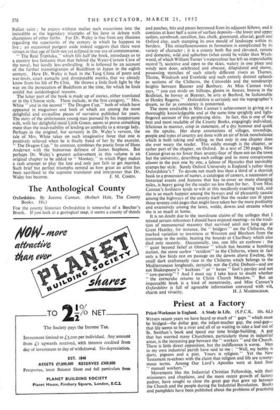The Anthological County
FOR the county historian Oxfordshire is somewhat of a Beecher's Brook. If you look at a geological map, it seems a county of shreds and patches, bits and pieces borrowed from its adjacent fellows, and it contains at least half a score of surface deposits—the lower and upper oolites, cornbrash, corallian, lias, chalk, greensand, alluvial, gault and Oxford clay, each stamping its own mould of landscape within its borders. This miscellaneousness in formation is complicated by its variety of character ; it is a county both flat and elevated, remote and domestic, wild and sjiburban (what could be wilder than Wych- wood, of which William Turner's watercolour has left- an imperishable record ?), secretive and open to the skies, watery in one place and windy next door, celebrated and obscure, dilapidated and showy, possessing stretches of such utterly different rivers as Thames, Thame, Windrush and Evenlode and such entirely distinct uplands as sections of the Chilterns, the Cotswolds and the nondescript heights between Bicester and Banbury. As Miss Cannan truly says, " you can stride on hilltops, gloom in forests, browse in the Bodleian, be horsey at Bicester, be arty at Burford, be fashionable at Henley Regatta." Oxfordshire is certainly not the topographer's dream, so far as consistency is concerned.
The more creditable is Miss Cannan's achievement in giving us a thoroughly knowledgeable and at the same time sprightly and light- fingered account of this perplexing shire. In fact, this is one of the best and most readable of the County Books, engagingly individual, felicitous in manner, crisp in statement, of a dry humour and quick on the uptake. Her sharp annotations of villages, townships, people and types of country are done with an air of brisk nonchalance which is both taking and telling, so that only in one chapter does she ever weary the reader. This oddly enough is the chapter, or rather part of the chapter, on Oxford. In a text of 250 pages, Miss Cannan gives us no fewer than seventy-four of them not on the town but the university, describing each college and its more conspicuous alumni in the past one by one, a labour of Hercules that inevitably cramps her style. Surely Oxford University is England's rather than Oxfordshire's ? To devote not much less than a third of a shortish book to a procession of names, a catalogue of careers, a succession of historical events and features that has to cover so many changing miles, is heavy going for the reader no less than for her. Even Miss Cannan's liveliness tends to wilt at this needlessly exacting task, and she is so much happier among the byways and sd pleasantly caustic among the highways of the county itself that the reader can ill spare those seventy-odd pages that might have taken her the more profitably and extensively among the lanes, wolds, downs and streams where she is so much at home.
It is no. doubt due to the inordinate claims of the colleges that I missed certain references I should have enjoyed meeting—to the tradi- tion of monumental masonry that survived until not long ago at Great Hazeley, for instance, the " bodgers'" on the Chilterns, the marked variation to tawniness at Wroxton and Bloxham from the ironstone in the oolite, beating the bounds at Charlbury which also died only recently. Occasionally, too, one lifts an eyebrow : the " quiet beyond belief at Otmoor " which has become a bombing station, the stone curlew "resident" in the Chilterns, where in fact only a few birds rest on passage on the downs above Ewelme, the small dark craftsmanly race in the Chilterns which belongs to the Mediterranean longheads, certainly not the Celtic Dobuni—and are not Shakespeare's " kecksies " or " kexes " fool's parsley and not " cow-parsnip" ? And I must say I take leave to doubt whether " the corncrake returns to Christ Church Meadow." But an impeccable book is a kind of monstrosity, and Miss Cannan's Oxfordshire is full of agreeable information conveyed with wit,


































 Previous page
Previous page